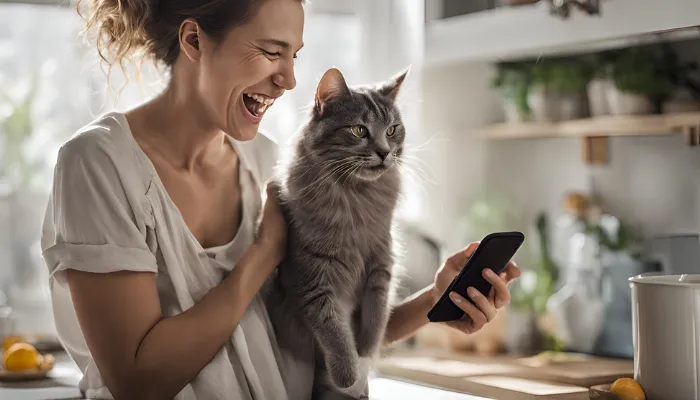Are Human to Cat Translators Real? With the rise of apps and gadgets claiming to decode your cat’s meows into human language, it’s easy to wonder if technology has finally bridged the communication gap between us and our feline friends. From playful meows to mysterious purrs, cats have a unique way of expressing themselves—but can an app truly translate those sounds into meaningful words?
In this article, we’ll explore the technology behind human to cat translator, their limitations, and whether science supports the idea of genuine cross-species communication.

Technology Behind Human to Cat Translators
With advances in technology, several apps and gadgets claim to translate cat sounds into human language. But Are Human to Cat Translators Real? or just clever gimmicks?
- Sound Recognition Technology:
- These tools analyze cat vocalizations and attempt to match them with pre-recorded sounds linked to specific meanings.
- Popular apps like MeowTalk claim to decode meows into phrases like “Feed me” or “Let me outside.”
- How These Devices Work:
- Recording Sounds: The app records your cat’s vocalizations.
- Sound Matching: It compares the recording against a database of known sounds.
- Output Translation: The app provides a probable translation based on similar sounds.
Table: Popular Human to Cat Translation Apps
| App Name | Features | Claimed Accuracy | User Feedback |
|---|---|---|---|
| MeowTalk | Custom profiles, AI learning, sound recognition | Moderate | Fun and engaging, but not always accurate |
| Human-to-Cat Translator | Pre-recorded sounds, simple interface | Low | Mostly for entertainment, lacks accuracy |
| Cat Communicator | Basic translations, sound matching | Low to Moderate | Mixed reviews, better for casual use |
While these apps offer fun ways to engage with your cat, true communication still relies on understanding your cat’s natural behaviors and cues.
Limitations of Human to Cat Translators
While these devices can be entertaining, there are significant limitations that prevent them from being true translators.
- Individual Variations:
- Just as every human has a unique voice, each cat has distinct vocal patterns. What one cat’s meow means may not apply to another.
- Contextual Differences:
- A meow that signals hunger in one situation might mean something entirely different in another.
- Limited Databases:
- The data these apps rely on is often too limited to account for the full range of feline vocalizations.
- No True Language:
- Cats don’t use a language in the same way humans do. Their communication is more about conveying needs and emotions rather than abstract ideas.
While fun to use, human to cat translators can’t replace the deeper understanding that comes from observing your cat’s unique behaviors and cues.
Scientific Perspective: Is True Translation Possible?
From a scientific standpoint, the answer to Are human to cat translators real? leans toward no. Here’s why:
- Fundamental Differences in Communication:
- Human language is symbolic and abstract, while cat communication is more instinctual and immediate.
- Cognitive Barriers:
- Cats don’t process language the same way humans do, making it difficult to establish a one-to-one translation.
- Current Research:
- While studies have explored animal communication extensively, translating between species remains a complex challenge. Most existing technology focuses on identifying patterns rather than true linguistic translation.
While technology can spot patterns, true human-to-cat translation isn’t scientifically possible, so understanding your cat relies on observing their behavior.
Why Do People Use Human to Cat Translators?
Despite their limitations, these translators have gained popularity. Here’s why:
- Entertainment: Many people enjoy the novelty of “communicating” with their cats.
- Bonding: Using these apps can enhance the interaction between humans and their pets, even if the translations aren’t accurate.
- Learning Tool: While not perfect, these devices can help people become more aware of their cat’s vocalizations and behaviors.
While not scientifically accurate, human to cat translators offer a fun way to bond with your pet and better understand their unique sounds.
Human-Cat Connection: Beyond Translation
Even if the answer to Are human to cat translators real? is a cautious no, that doesn’t mean we can’t understand our cats. Building a strong bond relies on observation, patience, and empathy.
- Observing Behavior: Spend time watching your cat’s reactions to different situations.
- Responding Consistently: Cats learn to associate your actions with specific outcomes, creating a mutual understanding.
- Building Trust: Trust is the cornerstone of any relationship, and the more secure your cat feels, the better you’ll understand each other.
True connection with your cat comes from trust and understanding, far beyond what any translator app can offer.
Conclusion
Are Human to Cat Translators Real? While some technology has advanced to recognizing and even trying to interpret some feline sounds, actual translation is yet to be achieved.
These gadgets have a light-hearted approach towards interacting with your pets and could help in understanding their primary needs. However, they are not reliable translators. At the end, cats and humans share a connection deeper than language, which is based on understanding and love.
